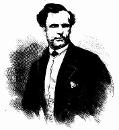This international person is included in AustLit to identify a relationship with Australian literature.
Born: Established: 25 Aug 1827 Long Island, New York (State),
 7168657513963126909.png
7168657513963126909.png
See also the full Australian Dictionary of Biography Online entry for Walter Montgomery.
The following item appeared in The New York Times, 27 April, 1873:
'Walter Montgomery's Will
The Australian papers state that the will of the late Walter Montgomery, actor, was proved in the Supreme Court on 6th of February by Mr. Thomas Pavey, the Australian executor. The will was made in 1868 in Melbourne, and was executed in duplicate, one copy being left with Mr. Pavey, and the other sent to the English executors - Mr. Forsyth, of Islington, and Rev. W. Drake, of Grantham. There were a few curious paragraphs in the will. One was: "I give and bequeath to the said John Forsyth the sapphire ring, and one ruby and one diamond ring, given to me on board the Galatea by his Royal Highness the Duke of Edinburgh." "I give and bequeath to his Royal Highness the Duke of Edinburgh the watch-chain manufactured for me by Mr. Crisp, jeweler, Melbourne, the same which I have already offered to His Royal Highness at Sydney, in the colony of New South Wales, but which he declared he would not deprive me of." 'With respect to certain sums of money owing to me by some of my friends whom I have at times obliged, I wish the said John Forsyth and William Drake to insert advertisements in the Times newspaper for about a week, reminding them politely of my desire and request for (if convenient) payment of the same. It may be that some few friends of mine may desire some little memorial of me. If so, let them give the market-price of the valuables, and the proceeds may be added to and form part of my personal estate."'
The Illustrated Sydney News gives the date of Montgomery's first appearance on the Australian stage as 22 July 1867.